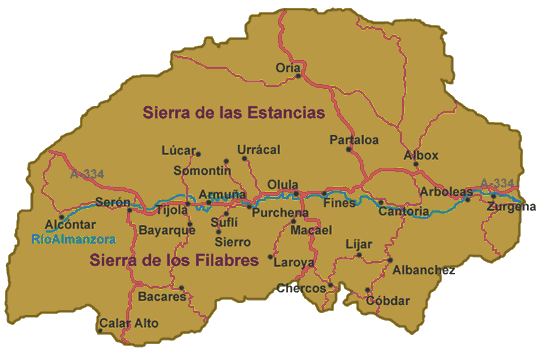The Almanzora Valley
The Almanzora River (Spanish: Río Almanzora) is a river in the province of Almería in Andalusia, Spain which rises on the northern slope of the Sierra de Los Filabres on the border between the provinces of Granada and Almeria. It passes through the cities of Seron, Tíjola, Purchena, Cantoria, Albox, Arboleas and Zurgena, then close to the town of Huercal Overa and through Cuevas del Almanzora before emptying into the Mediterranean Sea at Punta del Rio, just between Palomares and Villaricos, after a journey of 90 kilometres (56 mi).

It was in 985 AD that the valley got its present name. Ibn Abu Amir, known as Al Mansur (the victorious one), the ruler of the Caliphate of Al Andalus, journeyed from the capital of Cordoba to inspect the lands of this region. It was then that the river became known as Wadi Al Mansur. Before that, the Ancient Romans called it the Surbo, from Latin flumen superbum, "superb river", for its terrible floods. After torrential rains it continues to become swollen as in September 2012 and a previous major flood occurred in October 1973.
The river is fed from the mountain streams coming out of the Sierras and the melting winter snows, but for most of the year it has dried to a trickle by the time it reaches Cantoria 2000 feet below its source, and for the remaining 1000 feet drop before it enters the Mediterranean at Villaricos it has become a sandy expanse.
Seron lies in a magnificent landscape of vines and citrus trees, the whitewashed houses nestle on the hillside with a 13th Century castle standing guard over the houses. Seron is rich with heritage and has been settled since prehistoric times. Alcontar whose economy is based on agriculture, borders the province of Granada. The source of the Rio Almanzora lies within its boundaries and walking is popular in this area
Tijola is known as the Pearl of Almanzora or Little Granada. It stands on a beautiful fertile plain in a valley formed by the Sierra de las Estancias and the Sierra de los Filabres. It has a Mudejar style church, the Iglesia Parroquial de Santa Maria with a separate chancel. Also several archaeological remains.
Purchena lies at the foot of the Sierra de los Filabres surrounded by woods. Purchena has a wealth of history and its tranquil atmosphere belies its past. The legacy of it past is left with the ruins of the Torre del Agua (water tower), the Alcazaba (castle) and the 16th Century Iglesia Parroquial de San Gines (Parish church).
Albox is a typical whitewashed village with narrow streets interspersed with small plazas; it has an air of wealth and prosperity, as it has been a local commercial centre since the 19th Century.
Cantoria is a town that relies on the production of marble, as is its main resource, although it stands on a fertile plain producing agricultural goods. The town is more uniform with straight streets compared to its neighbours. Also in the marble zone lies Olula Del Rio, as with Cantoria this valuable asset is its main resource. There are several archaeological remains, the Verde Olula and caves, Cueva de Humosa. As a sign of its main resource, the church is completely decorated in marble.
Further down the valley in spurs of the Sierra de los Filabres Mountains lies Arboleas with a much drier landscape in contrast to the fertile land higher up the valley. There are an abundance of orange and lemon citrus together with almond fruit trees populating the area. Currently the pueblo is undergoing a change where the production of olive oil is being developed.
Zurgena lies in the lower basin of the Rio Almanzora; the river divides the village with the old village standing on a hill. The Mudejar style church stands majestically tall above the village houses.
Cuevas del Almanzora is one of the oldest towns of the province and built in a fertile basin of the River. In the early 19th century silver was discovered in the Sierra Almagrera Mountains. The news spread like wild fire and Cuevas became home to many a fortune hunter. The town got its name from the many artificial caves in the nearby hills once inhabited by the miners.

